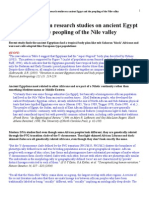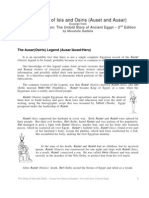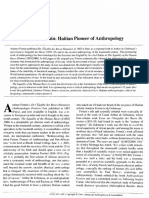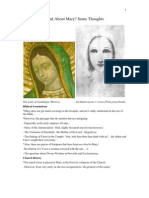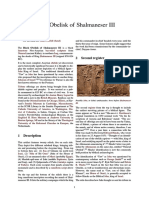The Bones of Hen Nekht, An Egyptian King of The Third Dynasty
The Bones of Hen Nekht, An Egyptian King of The Third Dynasty
Uploaded by
Michael C-y TungCopyright:
Available Formats
The Bones of Hen Nekht, An Egyptian King of The Third Dynasty
The Bones of Hen Nekht, An Egyptian King of The Third Dynasty
Uploaded by
Michael C-y TungOriginal Title
Copyright
Available Formats
Share this document
Did you find this document useful?
Is this content inappropriate?
Copyright:
Available Formats
The Bones of Hen Nekht, An Egyptian King of The Third Dynasty
The Bones of Hen Nekht, An Egyptian King of The Third Dynasty
Uploaded by
Michael C-y TungCopyright:
Available Formats
127. The Bones of Hen Nekht, an Egyptian King of the Third Dynasty.
Author(s): Charles S. Myers
Source: Man, Vol. 1 (1901), pp. 152-153
Published by: Royal Anthropological Institute of Great Britain and Ireland
Stable URL: http://www.jstor.org/stable/2839307 .
Accessed: 30/08/2014 00:59
Your use of the JSTOR archive indicates your acceptance of the Terms & Conditions of Use, available at .
http://www.jstor.org/page/info/about/policies/terms.jsp
.
JSTOR is a not-for-profit service that helps scholars, researchers, and students discover, use, and build upon a wide range of
content in a trusted digital archive. We use information technology and tools to increase productivity and facilitate new forms
of scholarship. For more information about JSTOR, please contact support@jstor.org.
Royal Anthropological Institute of Great Britain and Ireland is collaborating with JSTOR to digitize, preserve
and extend access to Man.
http://www.jstor.org
This content downloaded from 130.216.158.78 on Sat, 30 Aug 2014 00:59:33 AM
All use subject to JSTOR Terms and Conditions
MAN.
1901.]
[No. 127.
Egypt.
Myers.
The Bones of Hen Nekht, an Egyptian King of the Third Dyncasty.
By
127
Charles S. Myers (Cf. MAN, 1901. 131).
From arelheological data, it appears that Hen Nekht ruled over Egypt in the Third
Dyinasty, about 4000 In.c. His tomb, with its contents of bones and pottery, was
discovered last seasornnear Girgeh, by Mr. John Garstang, to whom my thanks are due
for permission to publish these remarks before they are included in the official report,
which xvill appear later through the aid of the Egyptian Research Account.
The bones of Hen Nekht are interesting, not only because he is by far the earliest
known king whose remains have been founid, but because they are the first which can
SIDE.
BACK.
p~~~~~~~
FRONT.
TOP.
with any certainty be dated as belonoino to the Third Dynasty. They proclaim him to
have been a man of iuniusual height. His stature probably exceeded 1870 millimetres,
wbile the average stature of later and prehistoric Egyptians was 1670 millimetres. The
proportions of his long bones to one another were such as characterise negroid skeletons,
a condition frequently observed in the prehistoric period, and commonly in the later
period of the early empire. The skull was very massive and capacious, and extraordiinarily broad for an Egyptian, the cranial index coming almost within the bounds of
[ 152 ]
This content downloaded from 130.216.158.78 on Sat, 30 Aug 2014 00:59:33 AM
All use subject to JSTOR Terms and Conditions
MAN.
1901.]
[Nos. 127-128.
bracliycephaly. Its features agreed more closely with those of dynastic than with
those of prehistoric skulls.
We turn now to history for the mention of an early Egyptian king of phenomenal
stature. To such a king both Manetbo and Eratosthenes allude. According to the
former historian he was Sesochris, penultimate king of the Second (Thinite) Dynasty;
according to the latter he was Momcheiri, first king of the Third (Memphite) Dynasty.
It is in the highest degree probable that these are two names of one and the same king.
The view I here offer,seoms to solve many difficulties.
Mr. Randall-Maclver's measurements mnakeit probable that from the late prehistoric
times onward, a people distinguished by broader heads, louger noses, a-ndother characters
gradually made their way and became absorbed into the long-headed population of This
and its neighbourhood. These broader-headed people formed the ruling class of the
earliest dynasties.
According to history and tradition they founded Memphis, and
doubtless multiplied there. By the Third Dynasty, according to Manetho, they beganto
build houses of hewn stone, and probably they constructed the earliest Egyptian
pyramids. They developed at Memphis a remarkable school of sculpture, soon producing
the most life-like wooden statue of a man that has ever been made ; he, too, was broadheaded. Up to the time of Hen Nekht, the broader-headed line of kings styled themselves Thinite, and continued to be buried near Tbis, in conformity with the ancient
tradition of the people with whom they had come into contact. In the end, however,
Memphis outvied This, and kings who succeeded Hen Nekht began to forsake the
simple Thinite burials for the pyramids of Saqqarah, Gizeh, and Abousir. Thus Hen
Nekht may be considered in name and culture to be of the Third. or Memphite Dynasty;
but, by his burial near This, came to be regarded as belonging to the previous Thinite
Dynasty.
The broader-headed race above mentioned is commonly thought to have arrived
first in the Nile Valley at Koptos (Quft) from Punt, a land sacred to the later Egyptians,
the situation of which it is conjectured was near Somaliland and the opposite coast,
There is, however, some geological evidence to show that the Red Sea extended in
historic times through the lakes near to Ismailia. Accordingly the people of Punt,
wandering northward from their home along the shores of the Red Sea, could conceivably
have made their way with ease to the Nile Valley nearer Memphis. It is, however, not
less probable that Asia rather than Punt was the home of this broader-headed race.
The earliest dynastic Egyptians used the Babylonian seals and the Babylonian cubit.
To Asia and Central Europe we are wonit to look for the broader-headed people.
Moreover, according to the Greek legend,* Memphis was founded by the marriage of
Memphis, daughter of the Nile, with Epaphus, who born of' the Grecian lo (Isis) was
carried off when a babe to Syria, and brouglht back by his mother to Egypt.
Scotland:
Pigmentation.
Gray:
Tocher.
128
The Frequency and Pigmnentation Value of Surnames of School Children in
East Aberdeenshire. By J. F. Tocher, F.I.C., and J. Gray, B. Sc.
IU
In the course of a pigmentation survey carried out by us in East Aberdeenshire in
1896 and 1897 we obtained the statistics of the surnames and pigmentatio-n of 14,561
(practically the whole) school children there. An analysis of the physical characteristics,
apart from the surnames, has already been published.t The present paper deals with
the distribution of the frequency of surnames and their correlation with pigmentation.
We have found that among the 14,561 children there are 751 different surnames. The
frequency of these surnames varies between 1 and 267, Milne being the most frequent,
the next in order being Smith, Taylor, Stephen, and Bruce. If the surnames are
* Cf. Ridgeway, Eatrly Age of Greece, I. 217.
t Joworn.AntAfr,Inst. Vol. XXX., pp. 104-125,
1bZ5 j
This content downloaded from 130.216.158.78 on Sat, 30 Aug 2014 00:59:33 AM
All use subject to JSTOR Terms and Conditions
You might also like
- Maxon Robert. - East Africa - An Introductory HistoryDocument345 pagesMaxon Robert. - East Africa - An Introductory HistoryAlexandre Nemirovsky0% (1)
- A Place Called Heaven - Gary WoodDocument85 pagesA Place Called Heaven - Gary Woodvincentansong4No ratings yet
- Robert Schoch - Voices of The RocksDocument326 pagesRobert Schoch - Voices of The RocksEntony100% (1)
- Population Fluctuation Over 7000 Years in EgyptDocument52 pagesPopulation Fluctuation Over 7000 Years in EgyptMichael DongNo ratings yet
- Lost Tribes of The Green SaharaDocument3 pagesLost Tribes of The Green SaharamonalallNo ratings yet
- QurnehDocument88 pagesQurnehflborrego100% (2)
- 3pm8stalp PDFDocument231 pages3pm8stalp PDFNenad MarkovićNo ratings yet
- Zeitgeist Source Book p1Document109 pagesZeitgeist Source Book p1thing21290100% (1)
- Flavius Josephus Between Jerusalem and Rome PDFDocument272 pagesFlavius Josephus Between Jerusalem and Rome PDFEddy Ebenezer100% (1)
- Egypt Exploration SocietyDocument6 pagesEgypt Exploration SocietyFady Nagy BotrosNo ratings yet
- Apis Bull StelaeDocument6 pagesApis Bull Stelaesychev_dmitryNo ratings yet
- Lip PlateDocument4 pagesLip PlateNaimi AzizNo ratings yet
- Quotations From Research Studies On Ancient Egypt and The Peopling of The Nile ValleyDocument22 pagesQuotations From Research Studies On Ancient Egypt and The Peopling of The Nile ValleyscribnilevalleyNo ratings yet
- ACTFLProficiencyGuidelines2012 FINALDocument53 pagesACTFLProficiencyGuidelines2012 FINALObadele KambonNo ratings yet
- SSRN Id4223391Document21 pagesSSRN Id4223391Eve AthanasekouNo ratings yet
- Isis OsirisDocument3 pagesIsis Osiriskbrown521No ratings yet
- The Art of Medicine in Ancient EgyptDocument1 pageThe Art of Medicine in Ancient EgyptMike GuoNo ratings yet
- 13 The Poetical Stela of Thutmose III: (Cairo Museum 34010) IDocument16 pages13 The Poetical Stela of Thutmose III: (Cairo Museum 34010) IAngelika ErhardtNo ratings yet
- Lahun TextDocument46 pagesLahun TextAngelo_ColonnaNo ratings yet
- Ancient Egyptians Belief of The AfterlifeDocument7 pagesAncient Egyptians Belief of The AfterlifeDrew Wofford100% (1)
- Geographic Distribution of Environmental Factors Influencing Human Skin Coloration.Document11 pagesGeographic Distribution of Environmental Factors Influencing Human Skin Coloration.Simon HenriquezNo ratings yet
- Ambiguous ImagesDocument14 pagesAmbiguous ImagesWesley MuhammadNo ratings yet
- W.M.F. Petrie-Medum - 1892Document140 pagesW.M.F. Petrie-Medum - 1892treb1212No ratings yet
- Petrie SeasonDocument122 pagesPetrie Seasonblueingrey100% (1)
- Articule - Tell El-Farkha - Cialowicz Krzysztof MDocument14 pagesArticule - Tell El-Farkha - Cialowicz Krzysztof MGerardo P. TaberNo ratings yet
- Chapter 6. Egypt and Sudan Old Kingdom To Late Period (World Archaeology at The Pitt Rivers Museum)Document25 pagesChapter 6. Egypt and Sudan Old Kingdom To Late Period (World Archaeology at The Pitt Rivers Museum)Dan HicksNo ratings yet
- Nubian ComplexDocument22 pagesNubian ComplexWesley Muhammad100% (1)
- Petrie Abydos 2Document141 pagesPetrie Abydos 2Teodozja Rzeuska100% (2)
- HancockG2 Origins of Consciousness Veritas Graham Hancock PDFDocument4 pagesHancockG2 Origins of Consciousness Veritas Graham Hancock PDFDevadoss GovindarajNo ratings yet
- Narmer and The Concept of The RulerDocument11 pagesNarmer and The Concept of The RulerNabil RoufailNo ratings yet
- Firmin Antropologia Positiva PDFDocument18 pagesFirmin Antropologia Positiva PDFFelipe Nunes100% (1)
- A Good Scribe and An Exceedingly Wise Man: Studies in Honour of W.J. TaitDocument20 pagesA Good Scribe and An Exceedingly Wise Man: Studies in Honour of W.J. Tait謝筠婷No ratings yet
- Anthes - Meaning of Maa XRW - JNES 13 (1954)Document32 pagesAnthes - Meaning of Maa XRW - JNES 13 (1954)Imhotep72No ratings yet
- Papyrus of Ani Egyptian Book of The Dead (Budge Translation)Document31 pagesPapyrus of Ani Egyptian Book of The Dead (Budge Translation)chvnxNo ratings yet
- Taylor Bryanne Woodcock, Noticing Neighbors: Reconsidering Ancient Egyptian Perceptions of Ethnicity, American Univ. Cairo 2014Document135 pagesTaylor Bryanne Woodcock, Noticing Neighbors: Reconsidering Ancient Egyptian Perceptions of Ethnicity, American Univ. Cairo 2014fcrevatinNo ratings yet
- His Image As Perfect As The Ancestors O PDFDocument18 pagesHis Image As Perfect As The Ancestors O PDFRenata TatomirNo ratings yet
- LexicografiaDocument331 pagesLexicografiamenjeperreNo ratings yet
- A Possible Explanation For The Legend of The QuinotaurDocument15 pagesA Possible Explanation For The Legend of The QuinotaurRichter, JoannesNo ratings yet
- The Reign of Thutmose IVDocument395 pagesThe Reign of Thutmose IVvalentinoNo ratings yet
- Cats in Ancient Egypt Reading Comprehension Exercises - 28335Document2 pagesCats in Ancient Egypt Reading Comprehension Exercises - 28335maian saja50% (2)
- Arkell 1955 Hator PDFDocument3 pagesArkell 1955 Hator PDFFrancesca Iannarilli100% (1)
- Ancient GenomesDocument19 pagesAncient Genomeshannibalbirca2No ratings yet
- Delia Jarce 29 1992Document11 pagesDelia Jarce 29 1992Angelo_ColonnaNo ratings yet
- Nabta Playa and Its Role in Northeastern African PrehistoryDocument27 pagesNabta Playa and Its Role in Northeastern African Prehistorydoerflinger8448100% (1)
- Ancient Egyptian Gods and GoddessesDocument3 pagesAncient Egyptian Gods and GoddessesNabil RoufailNo ratings yet
- A Lesson in Egyptian Determinatives: The Case of KMT: Luntu/lumtu/muntuDocument42 pagesA Lesson in Egyptian Determinatives: The Case of KMT: Luntu/lumtu/muntuHaqi JamisonNo ratings yet
- Alan Gardiner Egyptian HieroglyphsDocument37 pagesAlan Gardiner Egyptian HieroglyphsMohamed Ali100% (2)
- Pharaoh of MosesDocument11 pagesPharaoh of MosesdocwaNo ratings yet
- The Egyptian Coffin Texts 1 - Texts of Spells 1-75Document426 pagesThe Egyptian Coffin Texts 1 - Texts of Spells 1-75Melvin Jefferson100% (1)
- African Monotheism in Atenism PDFDocument17 pagesAfrican Monotheism in Atenism PDFSuzy SulimanNo ratings yet
- Emily Teeter Before Pyramids EgyptianDocument4 pagesEmily Teeter Before Pyramids EgyptianlatingeniusNo ratings yet
- Academia Ahmose NefertariDocument4 pagesAcademia Ahmose NefertariDr.Mohammed El-Shafey100% (1)
- Polotsky - Aramaic, Syriac and Ge'ez PDFDocument10 pagesPolotsky - Aramaic, Syriac and Ge'ez PDFRaas4555No ratings yet
- A Solar Litany From The Tomb of Ramesses PDFDocument6 pagesA Solar Litany From The Tomb of Ramesses PDFMohamed NassarNo ratings yet
- 2013ABCANGM NatufianForagersDocument25 pages2013ABCANGM NatufianForagersbayram kaçarNo ratings yet
- 63 IGI Tired The Eye of HorusDocument11 pages63 IGI Tired The Eye of HorusillyriankaNo ratings yet
- F. Tiradritti, "I Have Not Diverted My Inundation". Legitimacy and The Book of The Dead Ina Stela of Ramesses IV From Abydos, VO Quaderno I, 1997, Pp. 193-203Document13 pagesF. Tiradritti, "I Have Not Diverted My Inundation". Legitimacy and The Book of The Dead Ina Stela of Ramesses IV From Abydos, VO Quaderno I, 1997, Pp. 193-203Francesco Tiradritti100% (1)
- Egyptian Tales, Translated from the Papyri: First series, IVth to XIIth dynastyFrom EverandEgyptian Tales, Translated from the Papyri: First series, IVth to XIIth dynastyNo ratings yet
- The Sarcophagus of Hunefer and other New Kingdom Private SarcophagiFrom EverandThe Sarcophagus of Hunefer and other New Kingdom Private SarcophagiNo ratings yet
- The VoiceDocument2 pagesThe VoiceMichael C-y TungNo ratings yet
- HeideggerDocument12 pagesHeideggerMichael C-y TungNo ratings yet
- Great Solemnity - Coronation - C. of E PDFDocument372 pagesGreat Solemnity - Coronation - C. of E PDFMichael C-y TungNo ratings yet
- BVMDocument2 pagesBVMMichael C-y TungNo ratings yet
- Ur Excavations X Seal CylindersDocument118 pagesUr Excavations X Seal Cylindersdmore89No ratings yet
- Anglo Florentine GardenDocument340 pagesAnglo Florentine GardenMaria Laura RomeroNo ratings yet
- Ancient Lecture 12Document23 pagesAncient Lecture 12pooja sinhaNo ratings yet
- Construction of Desilting Chambers Naptha Jakri HEPDocument22 pagesConstruction of Desilting Chambers Naptha Jakri HEPsarvannnNo ratings yet
- 100 Passage 2 - Ancient People in Sahara Q15-27Document5 pages100 Passage 2 - Ancient People in Sahara Q15-27K60 Trương Thành TrungNo ratings yet
- BSA Sciweek Pack Secondary 1018v19 PDFDocument20 pagesBSA Sciweek Pack Secondary 1018v19 PDFJames CurranNo ratings yet
- The AetaDocument10 pagesThe AetaDaren DazNo ratings yet
- Kamus AntropologiDocument89 pagesKamus Antropologipandupandawa100% (2)
- Black Obelisk of Shalmaneser IIIDocument3 pagesBlack Obelisk of Shalmaneser IIIsolomonswisdomNo ratings yet
- Clasa 10Document4 pagesClasa 10Eugenia Ampava100% (1)
- Women in Paleolithic & Neolithic TimesDocument6 pagesWomen in Paleolithic & Neolithic TimesKekas MajčiNo ratings yet
- KVS STUDENT SUPPORT MATERICAL CLASS XII History PDFDocument184 pagesKVS STUDENT SUPPORT MATERICAL CLASS XII History PDFlalithNo ratings yet
- Testing of Augered Cast-In-Place Piles Installed With Varying Auger RotationsDocument16 pagesTesting of Augered Cast-In-Place Piles Installed With Varying Auger RotationsMUHAMMAD ALINo ratings yet
- U5 AssessmentDocument2 pagesU5 AssessmentClaudia CuelloNo ratings yet
- Insights November 2019 Current Affairs CompilationDocument153 pagesInsights November 2019 Current Affairs Compilationshubham panchalNo ratings yet
- TutorialDocument6 pagesTutorialAishwarya Singh Rathore100% (1)
- Old KingdomDocument2 pagesOld KingdomjamessonianNo ratings yet
- 1984 Mammoth-Bone Dwellings On The Russian PlainDocument13 pages1984 Mammoth-Bone Dwellings On The Russian PlainPredrag RadovićNo ratings yet
- Identification and Dating of Japanese Glass Beverage BottlesDocument11 pagesIdentification and Dating of Japanese Glass Beverage BottlesdukegarrikNo ratings yet
- 9 Victims of King Tut's Curse (And One Who Should Have Been)Document5 pages9 Victims of King Tut's Curse (And One Who Should Have Been)ThabisoNo ratings yet
- Terratec RBM BrochureDocument5 pagesTerratec RBM Brochuremanuel_plf100% (1)
- The 16 Greatest Cities in Human History, From Ancient Jericho To Modern Tokyo - Business Insider IndiaDocument64 pagesThe 16 Greatest Cities in Human History, From Ancient Jericho To Modern Tokyo - Business Insider IndiaanupamaniroopNo ratings yet
- Zivko Mikic - Anthropological Traces of Slav Presence in Kosovo and MetochiaDocument11 pagesZivko Mikic - Anthropological Traces of Slav Presence in Kosovo and MetochiaVasko GligorijevicNo ratings yet
- Kelly, R - Mobility-Sendentism - Concepts, Archaelogical Measures and EffectsDocument25 pagesKelly, R - Mobility-Sendentism - Concepts, Archaelogical Measures and EffectsjoaofontanelliNo ratings yet
- 490: Monmouth Football Club. Desk Based Assessment. APAC. LTDDocument15 pages490: Monmouth Football Club. Desk Based Assessment. APAC. LTDAPAC LtdNo ratings yet
- Villages, Cities and Ethne in Upper MacedoniaDocument28 pagesVillages, Cities and Ethne in Upper MacedoniaMakedonas Akritas100% (1)
- MesopotamiaDocument2 pagesMesopotamiaRaymar Velasco BronNo ratings yet
- The Alfred JewelDocument6 pagesThe Alfred JewelIngrid MaschekNo ratings yet













